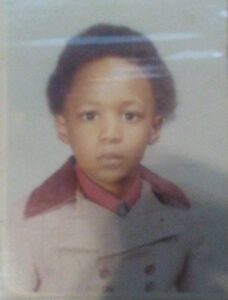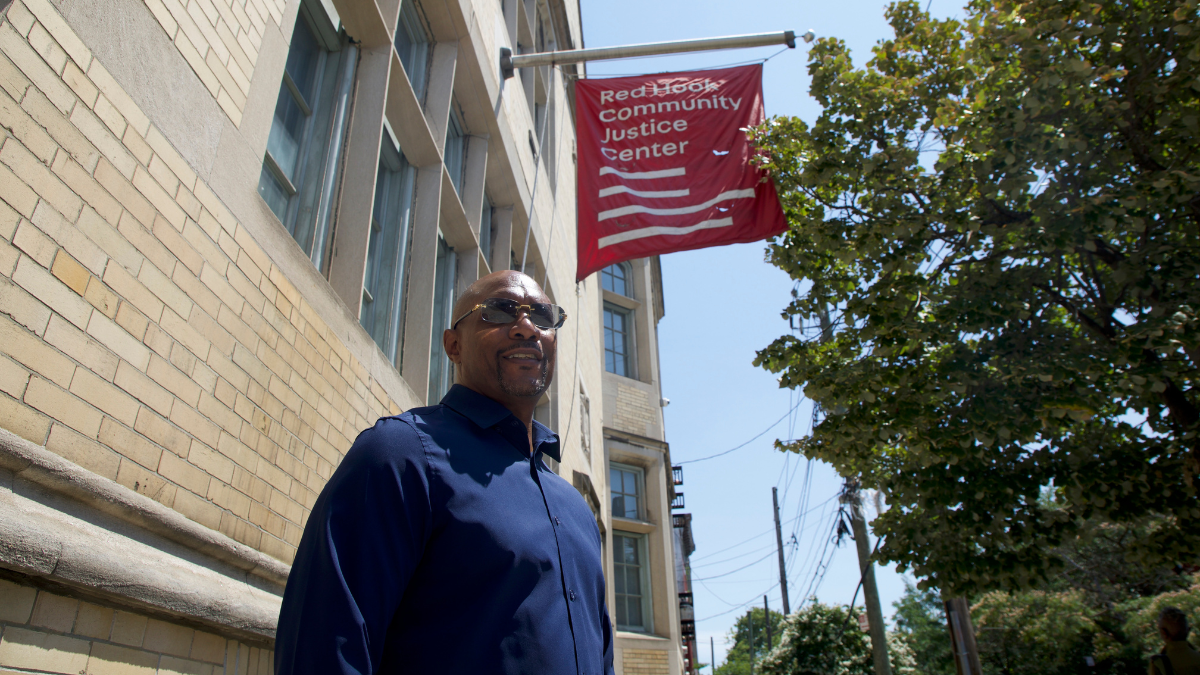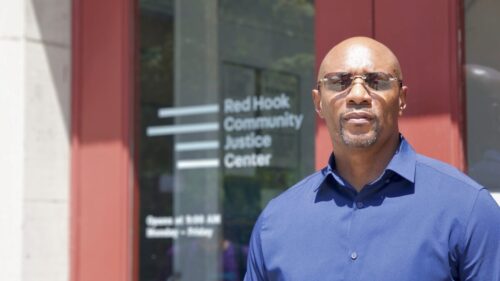A conversation with Thaddeus Canty, Project Director of the Red Hook Community Justice Center.
Could you talk a bit about your background—where did you grow up, and what did your journey look like before coming to the Center?

I’m a native of Brooklyn, New York, and I come from neighborhoods where we see some of the same things Red Hook is facing—poverty, violence. I also come from a strong family background; I’ve learned how to navigate through systems of inequality that weren’t built with those neighborhoods in mind. My journey to get where I’m at now has come through my background of community work, public health work, and just trying to help people get on board with the things they need to get their lives on track.
What is the Red Hook Community Justice Center?
The Red Hook Community Justice Center is the nation’s first multi-jurisdictional center where there’s a community court housed right in the community for residents. What makes it so important is that there’s a whole set of wraparound supportive services here all under one roof—you can get access to mental health services, to youth programs, to housing resources, to workforce development programs. So it’s just that total wraparound support of services that are specifically built for the community to thrive.
How did you come to the Community Justice Center originally?
I’ve done a lot of work with community organizing and youth development, and in doing that work I always envisioned somewhere where those supports and services would be all in one building. My journey wasn’t straightforward. I have lived experience with the carceral system, and I felt a need to give back to communities because I understood how certain inequalities prevented people from thriving. Throughout my career I’ve worked with youth and young adults facing all different kinds of issues—education, housing, mental health needs. And when I came here to the Center, this was something I envisioned as the point I’ve arrived where I felt that I was needed most.
What does an average day look like at the Justice Center?
There really is no typical day at the Justice Center, because one minute we could be hosting workshops, we could be mediating a conflict, we could be linking someone to mental health services. There’s a lot that could be going on in one day—it’s not scripted, and at any time things can change. The way I try to make sure I’m leading in the way I need to be leading is by understanding the work that’s being done on the ground and what our staff are facing. So I check in with people, walking around the building to connect with all of our different programs here.
How do you think your experiences have shaped the way you lead as Project Director here?
My personal lived experience with systems that were really not designed with people from these communities in mind—based on that and all of my community organizing work, I was able to understand what was really needed in these communities. So I just dedicated my life to reaching out to community members and making changes, trying to help people transcend the boundaries and challenges they face in order to get their lives back in order.
What are some of the main challenges of doing this work and how do you respond to them?
Sometimes it’s limited resources, often due to disinvestment in the community. There can also be staff burnout, which is why it’s so important to make sure that the people who are on the ground doing the work are supported in the ways they need to be supported. The way we respond is just with empathy, with understanding, and by welcoming all kinds of ideas that can help us navigate through those challenges to make sure, most importantly, our communities are served the way they need to be served.
What do you think makes the Red Hook Community Justice Center and its approach unique?
That we’re not just a community courthouse—this is a place where so many services can be accessed under one roof. At a lot of places, you have to be sent out to go somewhere else for services. What makes this unique is that our judge has the ability to send people to programs that are right here in the building. So if you have someone who comes here and they’ve been arrested, the concern is not just, “Alright, you committed a crime.” What we really want to do is to make sure you’re connected to support for whatever needs you have, in order to ensure that you don’t come back here for that reason. We want people to come back to access all of the services that we offer.

What keeps you motivated in this work?
What keeps me motivated is hearing success stories. Hearing people who have come through our doors express how much we’ve helped them navigate through the challenges and getting them to a better space in their lives. That’s what keeps me going—knowing that the work we’re doing is meaningful and that we are making an impact.
When you think about the future of the Community Justice Center, what do you envision?
I envision a broader reach to different resources in the community—being even more impactful and helping to reduce crime in ways that weren’t imagined before. And we get there by listening to community voices—going out, hearing people’s concerns and needs, and then bringing it back to the table for us to be innovative about how we’re going to move forward with addressing those needs.
What are you passionate about outside of your work?
So I’m a grandfather, I’m passionate about family. I love talking to kids and people in general, in and outside of work—to share my story, to empower people to know that whatever you’re dealing with, there’s always other options that exist outside of what you see every day in your neighborhood. You can come to a point where you get past all of those obstacles, and I use myself as an example of that. I think it’s so important to show people that you care and that you want to look out for the community.
